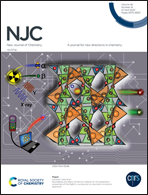Elucidating the effect of intrinsic defects on the dosimetric properties of the MgB4O7 compound: an atomistic simulation approach†
Abstract
MgB4O7 has attracted much attention for dosimetric applications in recent years, for reasons including its low effective atomic number and large bandgap to accommodate charge carrier traps. Particularly, the charge carrier traps in undoped MgB4O7 may be associated with natural defects in the host matrix, generated during the synthesis processes or even during post-synthesis treatment. Their elucidation is the key to controlling point defects in the host matrix and obtaining desirable dosimetric characteristics. In this context, we have estimated the intrinsic defect formation energy and its creation mechanism using the Mott–Littleton method. For this, we developed a new set of potential parameters based on the Buckingham and Morse potentials. The potential parameters were validated and used to obtain the structural, mechanical, and dielectric properties. Also, we connected these intrinsic defects with charge carrier traps for understanding the origin of optically stimulated luminescence (OSL) of the undoped material. The theoretical OSL decay pattern was obtained using a set of rate parameters. The results provide new insights into the control of defects and pave the way for discussing features of the doped material.



 Please wait while we load your content...
Please wait while we load your content...